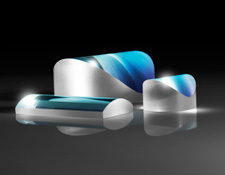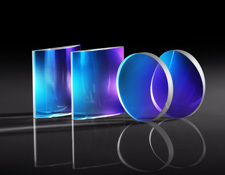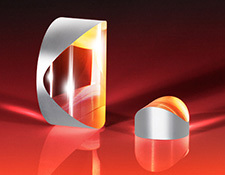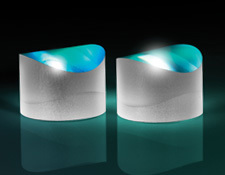
|
|
Tightly Controlled Optical and Geometric Tolerances |
|
|
Rectangular and Circular Form Factors Available |
|
|
3 Performance Tiers Available: Illumination, Imaging, Beam Shaping |
|
|
In-House Design and Coating Capabilities for Custom Requests |
|
|
In Stock for Immediate Delivery |
|
|
N-BK7, UV Fused Silica, and N-SF5 Substrates Available |
Cylinder lenses are crucial to a wide range of laser applications including circularizing elliptical beams from a laser diode, focusing a diverging beam onto a linear detector array, creating a light sheet for measurement systems, or projecting a laser line onto a surface. They are similar to spherical lenses in the sense that they use curved surfaces to converge or diverge light, but cylinder lenses have optical power in only one dimension and will not affect light in the perpendicular dimension. Edmund Optics® is a premier provider of cylinder lenses including achromatic, acylindrical, plano-convex, and plano-concave lens geometries.
The three most common applications of cylinder lenses include forming a laser line, forming a laser sheet, and circularizing an elliptical laser beam.
Edmund Optics® offers Cylinder Lenses with circular, rectangular, or oblong dimensions. Multiple anti-reflection coating options are available from the ultraviolet to the infrared, including UV-AR, UV-VIS, MgF2, VIS-NIR, VIS 0°, NIR I, or NIR II. Achromatic Cylinder Lenses provide additional color correction by minimizing chromatic aberration. Full prescription data is available for download, in addition to 2D or 3D models.
| Product Family | Wavefront Error | Surface Quality | Wedge Tolerance | Product Breadth | Chromatic Correction | Price |
|---|---|---|---|---|---|---|
| Illumination Cylinder Lenses | Undefined |
GOOD
|
Undefined |
Absolute Best
|
No |
|
| Imaging Cylinder Lenses |
BETTER
|
GOOD
|
BETTER
|
BETTER
|
No |
|
| Beam Shaping Cylinder Lenses |
BEST
|
BEST
|
BEST
|
BEST
|
No |
|
| Acylinder Lenses |
BETTER
|
GOOD
|
GOOD
|
GOOD
|
No |
|
| Achromatic Cylinder Lenses |
GOOD
|
BETTER
|
BETTER
|
GOOD
|
Yes |
|
| Illumination Cylinder Lenses |
 Illumination Cylinder Lenses are the most economical option EO offers and have the most options for size and focal length; but they don’t have as tight performance tolerances. They are ideal for cost-sensitive illumination applications. View Product Pros:
Cons:
|
| Imaging Cylinder Lenses |
 Imaging Cylinder Lenses have better wavefront error and wedge tolerances than Illumination Cylinder Lenses, but they have the same surface quality and fewer size and focal length options. They are ideal for generating laser lines and laser sheets. View Product Pros:
Cons:
|
| Beam Shaping Cylinder Lenses |
 Beam Shaping Cylinder Lenses are an optimal pairing of tightly controlled tolerances and optimal pricing for volume integration. They are ideal for beam shaping applications such as circularizing elliptical beams from a laser diode, creating a light sheet for measurement systems, or projecting a laser line onto a surface. View Product Pros:
Cons:
|
| Acylinder Lenses |
 Acylinder Lenses have an aspheric surface that greatly reduces spherical aberration. They feature diffraction limited performance and are ideal for creating thin line profiles of monochromatic light sources. View Product Pros:
Cons:
|
| Achromatic Cylinder Lenses |
 Achromatic Cylinder Lenses consist of a positive low-index (crown) element and a negative high-index (flint) element cemented together to minimize chromatic and spherical aberration. They are ideal for use with broadband light sources due to their color correction. View Product Pros:
Cons:
|
 What wavelength range do EO’s cylinder lenses cover?
What wavelength range do EO’s cylinder lenses cover?
 What lens substrate materials are available?
What lens substrate materials are available?
EO offers cylinder lenses made of optical glasses including N-BK7, UV Fused Silica, N-SF5, and N-SF11..
 What is the difference between an achromatic cylinder lens and a standard plano-convex (PCX) cylinder lens?
What is the difference between an achromatic cylinder lens and a standard plano-convex (PCX) cylinder lens?
PCX cylinder lenses only use one substrate material and achromatic cylinder lenses use multiple substrates to correct for spherical and chromatic aberration. Achromatic cylinder lenses are ideal for applications requiring magnification in only one dimension where a thin line profile is essential. They offer several performance advantages compared to traditional cylinder lenses, including superior reduction of spherical and chromatic aberration at the image plane. When used with a LED source, Achromatic Cylinder Lenses are ideal for line generation. Typical applications include line generation with LED illumination sources and superior focusing with LED-based scanning devices. The illustration below compares a focused line with an Achromatic Cylinder Lens and one with a standard plano-convex (PCX) cylinder lens.

 Is it better to use a cylinder lens or an anamorphic prism pair to circularize elliptical beams?
Is it better to use a cylinder lens or an anamorphic prism pair to circularize elliptical beams?

or view regional numbers
QUOTE TOOL
enter stock numbers to begin
Copyright 2023 | Edmund Optics, Ltd Unit 1, Opus Avenue, Nether Poppleton, York, YO26 6BL, UK
California Consumer Privacy Act (CCPA): Do Not Sell or Share My Personal Information
California Transparency in Supply Chains Act